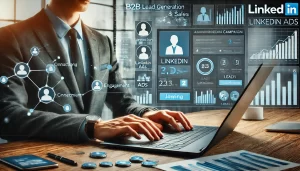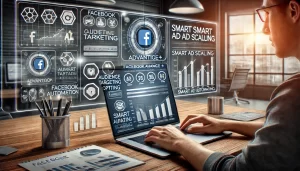Scaling a lead generation campaign is essential for business growth, but many advertisers struggle with rising costs, lower-quality leads, and diminishing returns.
The key to successful scaling is increasing lead volume while maintaining (or even reducing) Cost Per Lead (CPL). This requires strategic targeting, automation, and optimization.
In this guide, you’ll learn how to scale lead generation campaigns efficiently while keeping costs under control.
1. Ensure Your Campaign is Ready to Scale
📌 Before scaling, ask yourself:
✔ Are you generating high-quality leads that convert into customers?
✔ Do you have a consistent CPL with stable performance?
✔ Is your lead nurturing system automated to handle more leads?
✔ Have you identified your best-performing ads and audiences?
💡 Pro Tip: If your campaign is not yet profitable, don’t scale! Optimize first before increasing ad spend.
2. Optimize Targeting to Reduce Wasted Ad Spend
One of the biggest mistakes in scaling is expanding audiences too quickly, leading to higher CPL. Instead, refine targeting to improve efficiency.
📌 How to Scale Targeting Without Increasing Costs:
✔ Lookalike Audiences (Facebook & LinkedIn) → Scale by targeting users similar to your best leads.
✔ Custom Audiences (Google & Facebook) → Retarget website visitors, engaged users, and past leads.
✔ Refine Demographics & Exclusions → Remove low-quality leads (e.g., students if targeting business owners).
✔ Test New Platforms → If Facebook Ads work, expand to Google, LinkedIn, or TikTok.
💡 Pro Tip: Use Facebook Audience Insights and Google Analytics to identify high-converting audiences.
3. Increase Budget Gradually (Avoid Cost Spikes)
📌 How to Scale Budget Without Wasting Money:
✔ Increase budget by 20-30% every 3-5 days (scaling too fast increases CPL).
✔ Shift more budget to high-performing ad sets.
✔ Use automated rules to increase budget only on profitable campaigns.
💡 Pro Tip: If CPL starts increasing too much, pause scaling and optimize targeting.
4. Improve Ad Creatives to Maintain Engagement
As you scale, audiences see your ads more often, leading to ad fatigue and lower engagement.
📌 How to Keep Ads Fresh While Scaling:
✔ Create multiple variations of top-performing ads (change images, headlines, CTA).
✔ Test different ad formats (carousel, video, lead form ads).
✔ Use dynamic ads to automatically personalize creatives.
💡 Pro Tip: Refresh ad creatives every 2-4 weeks to maintain engagement and lower CPC.
5. Use Retargeting to Capture High-Intent Leads
Scaling isn’t just about finding new leads—it’s also about converting warm prospects efficiently.
📌 Best Retargeting Strategies to Scale Lead Generation:
✔ Website Retargeting → Show ads to visitors who didn’t sign up.
✔ Lead Nurturing Ads → Retarget people who engaged with your content but didn’t convert.
✔ Email List Retargeting → Run ads to past leads who haven’t taken action.
✔ Video Retargeting → Retarget users who watched 50%+ of your ad.
💡 Pro Tip: Retargeting reduces CPL by up to 50%—allocate at least 30% of your budget to it.
6. Automate Lead Qualification & Follow-Ups
Scaling brings in more leads, but not all are sales-ready. Automate lead qualification to filter out low-quality leads.
📌 How to Automate Lead Qualification:
✔ Use chatbots & AI-powered lead scoring (e.g., Drift, HubSpot).
✔ Send automated email sequences to nurture new leads.
✔ Use CRM systems (HubSpot, ActiveCampaign) to track lead engagement.
✔ Set up SMS or WhatsApp follow-ups for high-intent leads.
💡 Pro Tip: Following up within 24 hours increases conversion rates by 3x.
7. Test Different Lead Generation Campaign Structures
📌 Ways to Expand Without Increasing CPL:
✔ Try Lead Form Ads → Facebook & LinkedIn lead forms convert 2-3x higher than landing pages.
✔ Test Different CTAs → “Get a Free Guide” vs. “Schedule a Call”.
✔ Experiment with Lead Magnets → E-books, free trials, webinars, case studies.
💡 Pro Tip: Use heatmaps (Hotjar, Microsoft Clarity) to see where leads drop off and optimize landing pages.
8. Lower CPL with Smart Bidding Strategies
Scaling means spending more, but the goal is to maintain or reduce CPL.
📌 Best Bidding Strategies for Scaling Lead Generation:
✔ Target CPA (Google & Facebook Ads) → AI optimizes bids for lower CPL.
✔ Maximize Conversions → Increases lead volume at the best possible cost.
✔ Bid Adjustments → Lower bids on high-cost locations or age groups.
💡 Pro Tip: Let AI bidding run for at least 7 days before making changes.
9. Track & Optimize Lead Quality (Not Just Quantity)
📌 Metrics to Measure Lead Quality While Scaling:
✔ Cost Per Lead (CPL) → Lower is better, but not if quality drops.
✔ Lead-to-Customer Conversion Rate → Are leads actually becoming customers?
✔ Time to Close → How long does it take for a lead to convert?
✔ Engagement Rate → Are leads opening emails, clicking links, or attending calls?
💡 Pro Tip: If you’re getting more leads but fewer conversions, refine targeting and lead qualification processes.
10. Expand to New Channels While Maintaining CPL
📌 How to Scale to New Platforms Without Wasting Budget:
✔ If Facebook Ads work, test Google Search Ads for high-intent traffic.
✔ If Google Ads work, try YouTube Ads for video-based lead nurturing.
✔ Use LinkedIn Ads for B2B and TikTok Ads for younger audiences.
✔ Retarget leads across multiple platforms to stay top-of-mind.
💡 Pro Tip: Don’t expand too fast—test one new platform at a time to track performance.
Final Thoughts: Scaling Lead Generation Without Increasing Costs
Scaling lead generation doesn’t mean just increasing budgets—it requires strategic targeting, automation, and optimization.
📌 Key Takeaways:
✅ Refine audience targeting to reduce wasted spend.
✅ Increase budgets gradually to avoid cost spikes.
✅ Optimize ad creatives to prevent ad fatigue.
✅ Leverage retargeting to capture warm leads.
✅ Automate lead qualification & nurturing for efficiency.
✅ Track lead quality, not just quantity to maintain profitability.
✅ Expand to new platforms strategically to find additional leads.
🚀 Now it’s your turn! Apply these strategies and scale your lead generation campaigns profitably!




